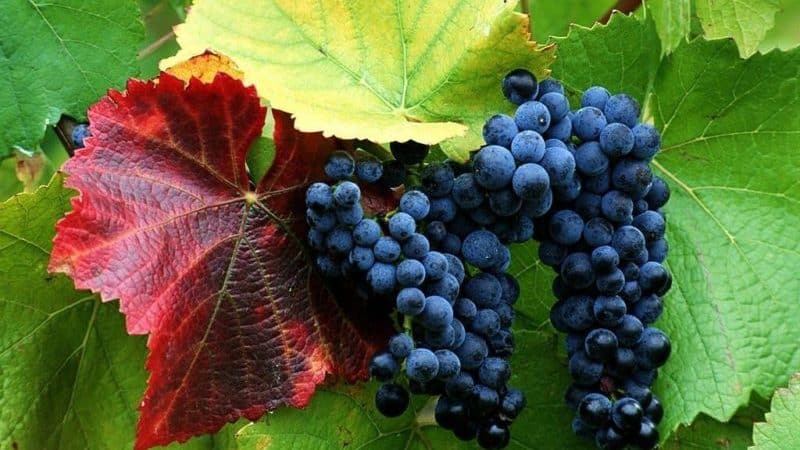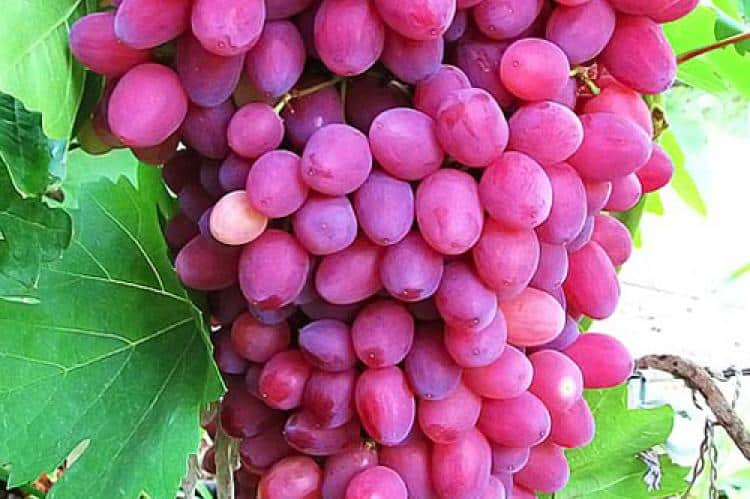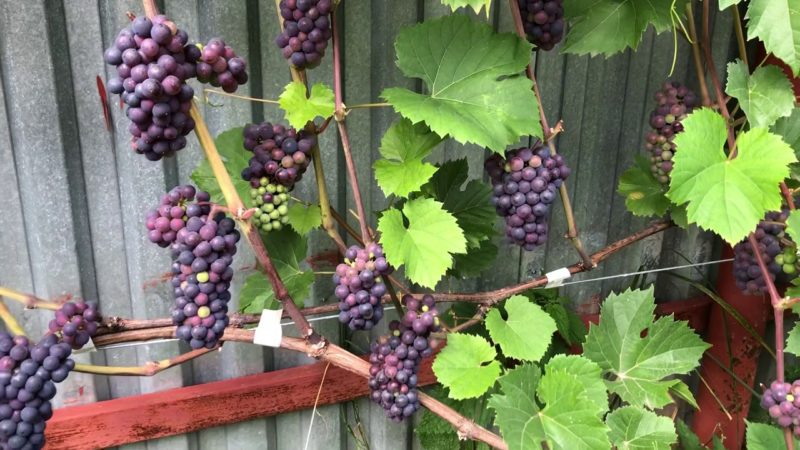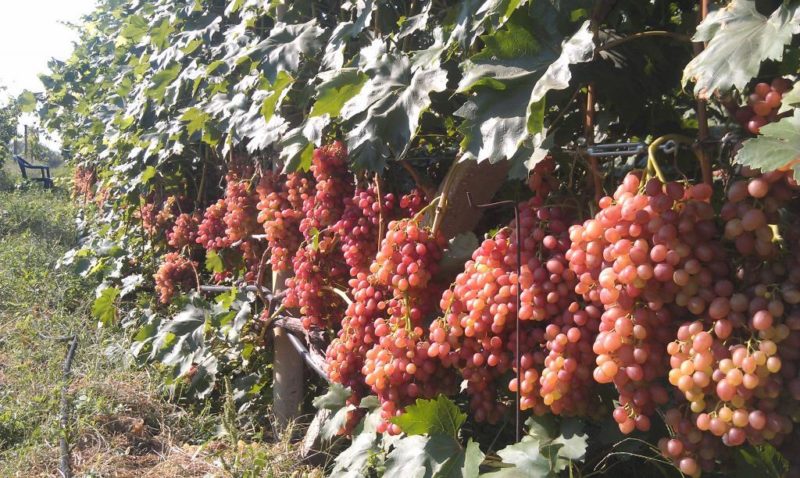Description and characteristics of raisin grape varieties
Grapes are a noble berry. Various dishes, wines, and juices are prepared from it, which have a rich taste. Kishmish is also loved because it has no seeds and is easy to eat and process.
There are many varieties of sultana grapes. Today we will talk about the most common of them, we will talk about their advantages and features.
General description of raisin grapes
Kishmish is a sweet, juicy dessert and table grape that is very popular.
The culture is rich in vitamins A, B, E, PP, and serves as a source of glucose, fructose and organic acids. The juice of ripe fruits contains a lot of calcium, potassium, iron, magnesium, sulfur, and phosphorus.
Kishmish has beneficial properties. Eating berries helps normalize blood pressure and supports the heart muscle. Fresh grape juice has an antiseptic effect.

Botanical description
Grape vines grow by attaching themselves to supports with tendrils and can reach 30 m in length. The leaves of the plant are petiolate, entire, with 3-5 lobes.
The crop blooms in May–June with small greenish flowers. The fruits are harvested in August – September.
Kishmish berries are medium in size, dense and have good keeping quality; they have no seeds. The pulp of the berries contains up to 25% sugar, which makes taste more saturated.
The clusters of sultanas are dense. Everyone has varieties As the fruits ripen, they have different colors and shapes. Kishmish, like ordinary grapes, has early, late and mid-ripening varieties.
Juices of maturation:
- early - 105-115 days from the beginning of the growing season;
- mid-season – 120-140 days;
- late ripening - from 150 to 170 days.
Also, sultana varieties are divided into groups according to the category of seedlessness. The highest quality ones have no seeds at all. The other group contains seeds, but their size is so small that it is not noticeable when eaten. Some varieties have large, full-fledged seeds.
Where do raisins grow?
Central Asia is considered the birthplace of the plant. The main areas where sultanas grow are Crimea, the North Caucasus, Dagestan, Kuban, and Stavropol.
Kishmish belongs to the southern crops, but breeders have developed recommendations growing it in central Russia and the Moscow region, in Siberia and the Far East. An important condition for growing in these regions is to help the grapes survive the winter.
Reference. Thanks to the special flexibility of the Kishmish vines, they are placed on arbors and arches. This allows the bunches to ventilate and also serves as a decoration for the garden plot.
The best sultana varieties and their characteristics
Despite the variety of raisin grape varieties, in each ripeness group there are several of the highest quality and most popular.
Early
Early ripening varieties give a good, abundant harvest even in the middle zone.

Kishmish 342, or Hungarian
Dessert variety consumed fresh, it is suitable for making wine and juices. The berries ripen at 110-115 days. The plant is tall, the clusters are large. The berries are light green with a golden sheen, tender, with a nutmeg flavor. The average fruit size is 16x18 mm.
Advantages include resistance to frost and fungal diseases. The fruits are also well digestible and ideal for drying. The main disadvantages are that the berries contain seeds; clusters picked at the wrong time quickly lose their presentation.
Aurora
Kishmish is consumed fresh and is also suitable for making wine. Aurora ripens in 110-120 days. It has conical, medium-sized clusters. The size of the berries is 15x15mm. The fruits are round, white-pink, juicy, sweet, with a strong skin.
Pros: high yield, frost resistance, good transportability. Disadvantages: instability to gray rot, attractive to birds.
Zaporozhye
It is considered a universal variety. Ripens at 110-120 days. The weight of the bunches reaches 1-2 kg. The berries are oval, small, purple in color. The pulp is juicy and sweet.
The main advantages are frost resistance (withstands temperatures down to -30°C) and high yield. Resistant to fungal diseases. Disadvantages of the variety: it is poorly stored, attracts insects, and is prone to overload with fruit if not properly cared for.
Mid-season
The varieties of this group are unpretentious in care.
Radiant
Table grape variety. Ripens in 125-135 days. The bushes are vigorous, the clusters are medium in weight from 500 g to 1 kg. The berries are cone-shaped, pink.
The main advantage is the sweet, juicy taste with notes of nutmeg. Another advantage of the variety is its resistance to many diseases, including gray rot. Tolerates transportation well. The disadvantage of this variety is its sensitivity to frost.
Moldavian
Delicious, juicy table raisins with a ripening period of 135-145 days. The plant is vigorous with large clusters weighing up to 600 g. The fruits are light purple, with a bloom, oval or round in shape. The weight of the berries is 4-6 g.
The main advantages are that they can be stored for up to 180 days, tolerate transportation well, and are resistant to frost. Disadvantages of the variety: it is often affected by gray rot and attracts pests (mainly leaf rollers).
Century
Widely used for making raisins. Ripens in 130-140 days.The clusters are heavy (up to 900 g), cone-shaped. The berries are oval, yellow-green, weighing up to 8 g, with thin skin. The berries are sweet, with a nutmeg flavor.
The advantages of the variety are high yield and versatility of use. The variety is also disease resistant. Disadvantages - does not tolerate transportation well and is not stored for long.
Late
Late-ripening varieties differ from others in their frost resistance.

Black finger
Refers to table varieties. Ripening period is 150-160 days. The clusters are cylindrical, large, weighing up to 2 kg. The berries are blue-black, oval, up to 3 cm long. The weight of one can reach 15 g. The berries are aromatic, with notes of nutmeg.
The main advantage is high productivity. The main disadvantage is sensitivity to disease.
White
Widely used in cooking and winemaking. The variety is suitable for growing in the middle zone and ripens in 170-180 days. The clusters are cylindrical in shape, their weight reaches 300 g. The berries are small, oval, yellow or light amber in color. The fruits are juicy with a sweet and sour taste.
The advantages include good frost resistance, and the disadvantages include low yield and poor transportability.
Important! Kishmish has a high calorie content. To avoid getting an undesirable effect instead of a benefit, it is recommended to limit the use of the product.
Red seedless grapes
Red sultana grapes are common due to their versatility. The varieties combine early-medium ripening and frost resistance (down to -29°C). Red sultanas belong to the table type. It is consumed fresh and juices are prepared.

Varieties of red seedless grapes:
- Red nutmeg. Ripens in 115 days and produces up to 5 kg of yield per bush. The average weight of the bunches is 750 g, the berries are 7 g. The fruits are oval and have a pronounced nutmeg taste.
- Kenadice. Ripening period – 120 days. The weight of the bunches is up to 500 g, the berries - up to 3 g. The fruits are round, juicy, sweet with the taste of Isabella.
- Kishmish Saturn. Ripens in 130 days. The clusters are conical, weighing up to 350 g. The berries are elongated, weighing 3-4 g. The pulp is sweet and juicy.
Conclusion
Despite the fact that sultanas are a southern crop, they have learned to grow them in other regions with harsher climates. The grapes are distinguished by their sweet taste, absence of seeds, versatility in consumption and abundance of varieties. By including sultanas in your diet, you will not only enjoy the taste, but also get a complex of vitamins. And grapes served at the table for dessert will please any guest.